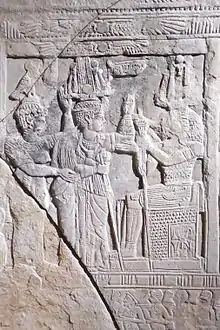Amanishakheto
Amanishakheto was a Kandake of Kush. She seems to have reigned from 10 BC to 1 AD, although most dates of Kushite history before the Middle Ages are very uncertain.
| Amanishakheto | |
|---|---|
| Kushite Queen of Meroe | |
 Stele of Amanishakheto (center) from the temple of Amun in Naqa | |
| Predecessor | Amanirenas |
| Successor | Amanitore |
| Died | 1 |
| Burial | Meroe (Beg. N 6) |
In Meroitic hieroglyphs her name is written "Amanikasheto" (Mniskhte or (Am)niskhete). In Meroitic cursive she is referred to as Amaniskheto qor kd(ke) which means Amanishakheto, Qore and Kandake ("Ruler and Queen").[1]
Monuments
Amanishakheto is known from several monuments. She is mentioned in the Amun-temple of Kawa, on a stela from Meroe, and in inscriptions of a palace building found at Wad ban Naqa, from a stela found at Qasr Ibrim, another stela from Naqa and her pyramid at Meroe (Beg. no. N6).[1]
Amanishakheto is best known for a collection of jewelry found in her pyramid in 1834 by Italian treasure hunter Giuseppe Ferlini, who destroyed the pyramid in search of its burial goods.[2] These pieces are now in the Egyptian Museum of Berlin and in the Egyptian Museum of Munich.
Gallery
 Usekh collar of the queen
Usekh collar of the queen Bracelet from the tomb of Amanishakheto in Nubia
Bracelet from the tomb of Amanishakheto in Nubia The Meroe pyramids. N6, the tomb of Amanishakheto, is highlighted
The Meroe pyramids. N6, the tomb of Amanishakheto, is highlighted- Some of the treasures found by Ferlini
References
- László Török, The kingdom of Kush: handbook of the Napatan-Meroitic Civilization
- Welsby, D. 1998: The kingdom of Kush: the Napatan and Meroitic empire. Princeton, NJ: Markus Wiener, pp. 86 and 185.
Further reading
- Laszlo Török, in: Fontes Historiae Nubiorum Vol. II, p. 723–725 (Bergen, 1996). ISBN 82-91626-01-4
External links
| Wikimedia Commons has media related to Amanishakheto. |

